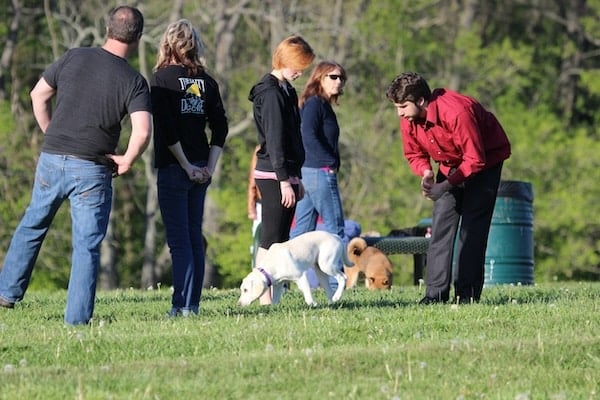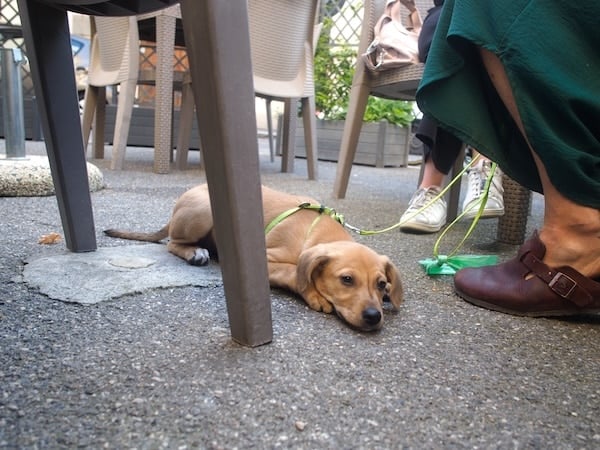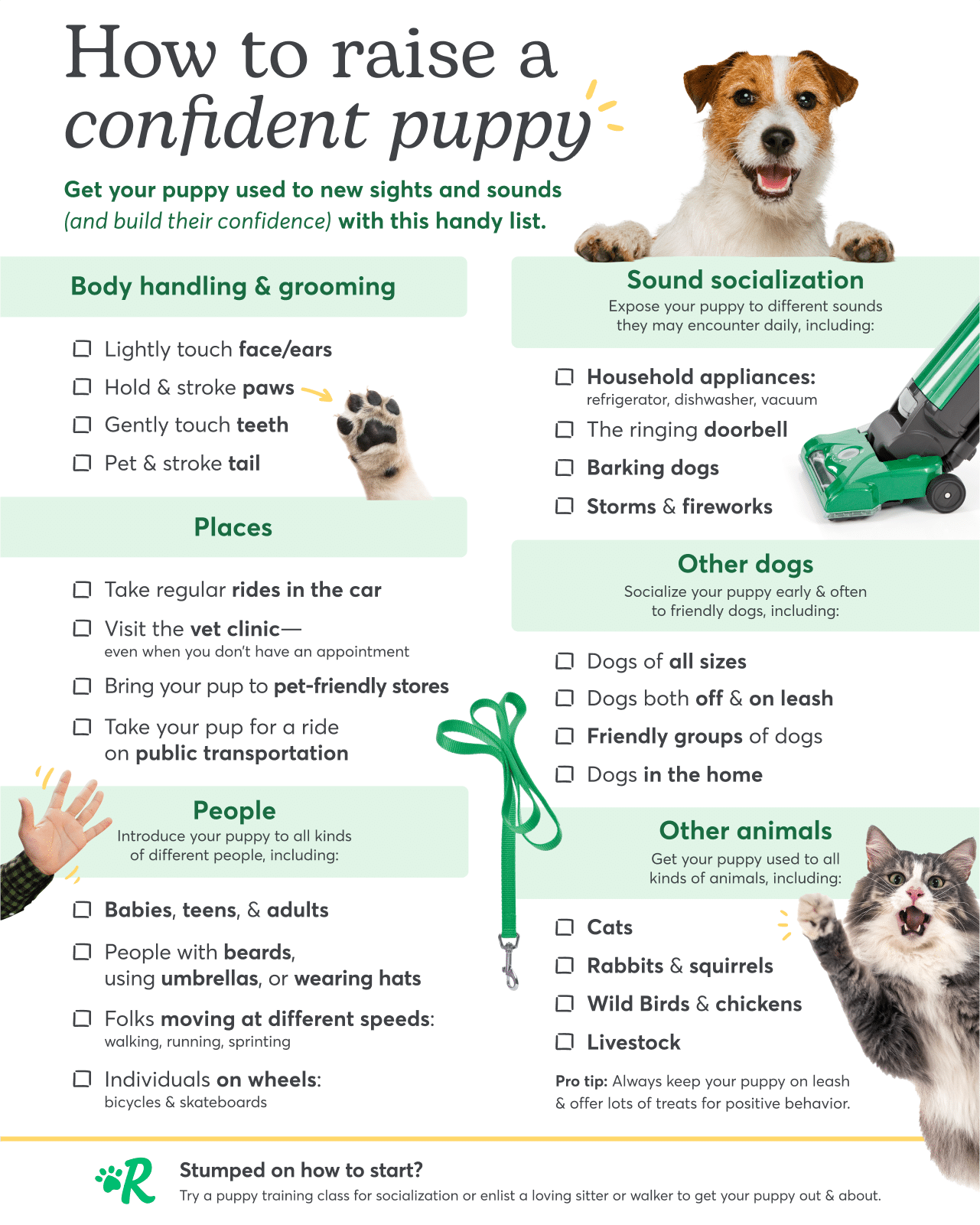- This post contains affiliate links. Read more here.
- This article has been reviewed by a pet health professional. It is not a substitute for professional veterinary advice.
Socialization is one of the most important things you can do for your puppy—but what does that actually mean? Puppy socialization is the process of introducing your pup to new experiences, people, animals, and environments in a safe and positive way.
Done right, socialization helps a puppy grow into a confident, well-adjusted dog. Under-socialization, by contrast, can raise a dog’s risk of fear, anxiety, and behavior issues later in life.
The challenge is that a puppy’s socialization checklist is long, but the critical socialization window is short, lasting from about 3 to 12 weeks of age. During this time, puppies are especially receptive to new experiences, making it the best time to introduce them to everything from new people and other dogs to car rides and doorbells. So how do you fit it all in?
With expert help from Kait Hembree, Head Trainer at GoodPup, we break down how to properly socialize a puppy.
Benefits of Puppy Socialization
Socializing your puppy early sets them up for a lifetime of confidence and comfort in new situations. In the short term, they’ll learn to navigate the world with curiosity instead of worry or fear. Long term, proper socialization helps prevent anxiety-driven behaviors and makes everyday outings—like vet visits, walks, and trips to the café—far more enjoyable for both of you.
“Socialization ultimately lowers the risk of what we as humans deem ‘inappropriate’ responses from our dogs in social situations,” explains Hembree.
A well-socialized dog is more likely to:
- Feel comfortable in new places, like dog-friendly restaurants and parks
- Engage comfortably when meeting new people and dogs instead of feeling overwhelmed
- Handle vet visits and grooming with less stress
- Adapt more easily to changes in their routine or environment
Early socialization can help prevent:
- Fear-based reactions to strangers, children, or other animals
- Anxiety in busy environments, like city streets or crowded parks
- Leash reactivity, including lunging, barking, or snapping
- Noise sensitivity to sounds like fireworks, thunder, or traffic
How Socialization Works
During the socialization window, a dog’s eyes and ears are fully developed, but their nervous system and hormone-regulating glands are still maturing. This means puppies are more open to learning, and their emotional responses are flexible. They haven’t yet learned to be upset about new experiences, and any negative experiences they do have are less likely to leave a lasting impression.
Hembree compares it to learning to ride a bike: because of both your physical and mental state, it’s much easier when you’re young.
A pet parent’s role during the socialization window is to introduce a puppy to as many new experiences as possible in a controlled and positive way. Every interaction should be gentle, rewarding, and tailored to their comfort level.
Of course, socialization comes with challenges. Puppies aren’t fully vaccinated during this critical window, making it tricky to introduce them to unknown dogs and busy environments. Another challenge is that new pet parents are typically navigating busy schedules and hectic puppy care—which can make it hard to schedule introductions to a wide variety of people, places, and situations.
But the effort is worth it, since proper socialization sets the foundation for a happy, healthy adult dog.

JerryGrugin via iStock
How To Socialize a Puppy
By properly socializing your puppy, you’ll help them learn to navigate the world with confidence—one positive experience at a time.
You’ll want to introduce your puppy to:
- Different types of people (children, seniors, people in hats, people with beards, etc.)
- Other friendly, vaccinated dogs and pets (cats, birds, livestock, etc.)
- Various environments (parks, pet-friendly stores and restaurants, car rides, the vet, etc.)
- Common household noises (vacuum cleaners, doorbells, kitchen sounds)
- Handling experiences (touching different parts of their body like their paws or ears to prevent future sensitivity)
We’ve put together a full socialization checklist for new pet parents.
Socialization works best when it’s done gradually and with a focus on creating positive experiences. Here’s a simple step-by-step guide to help you introduce your puppy to the world in a way that builds their confidence and helps them feel safe.
- Choose the the right time.
Pick a time when your puppy is well-rested. Trying to introduce them to something new when they’re tired or overstimulated can be frustrating. - Start small and take it slow.
Begin with low-stress environments before progressing to busier or noisier places. If introducing new people, start with one calm person before adding more to the mix. - Offer positive reinforcement.
Pair every new experience with treats, praise, and play. This helps your puppy form positive associations with new sights, sounds, and situations. - Watch their body language.
Look for signs that your puppy is comfortable—loose posture, soft eyes, and relaxed forward ears. If they show signs of stress (tucked tail, trying to back away, excessive yawning), give them space from what could be causing it. - Let them set the pace.
Never force your puppy to interact with something they’re unsure about, Hembree stresses. If they choose to step back, that’s okay! You can always try again another day. - Keep experiences short and positive.
If your puppy starts to seem tired or overwhelmed, wrap up the experience and praise them for doing a good job. - Repeat and vary the experiences.
Socialization isn’t a one-and-done process. Regularly expose your puppy to different situations to help them build confidence over time.
What Not To Do During Puppy Socialization Training
Socialization is about setting your puppy up for success, but there are some common mistakes that can make the process stressful instead of beneficial. Here’s what to avoid.
Not letting your puppy decide what they’re comfortable with
Always let your puppy make the decision to approach something new.
“It’s okay to encourage them with treats, pets, praise, or love, but if the puppy decides they’re not comfortable with it, we need to let them leave,” says Hembree. “Let them do what they need to do to feel safe.”
Forgetting to make new experiences positive
Exposure alone isn’t enough. New experiences should feel good for your pup! Reward your puppy with treats, praise, or play when they approach something new. If they associate new people, places, and sounds with positive outcomes, they’ll be much more likely to feel comfortable with them in the future.
Moving too fast
While it’s important to introduce your puppy to a variety of experiences, doing too much too quickly can be overwhelming. If your puppy seems hesitant or stressed, slow things down and introduce new experiences at a pace they can handle.

A_Columbo via iStock
Not ending an experience soon enough
A successful socialization session should end on a positive note. If your puppy is showing signs of discomfort or trying to leave, let them. Hembree says this will strengthen your bond with your dog, because you’re giving them the freedom to determine what makes them feel safe—and they learn they can rely on you to provide it.
Punishing your puppy for responding negatively
If your puppy growls, hides, or barks at something new, don’t punish them. This is their way of communicating that they’re unsure or afraid. Instead of scolding, help them feel safe by creating distance and reintroducing the experience more gently next time.
Socializing when they’re overtired
Just like people, puppies can get cranky when they’re exhausted. Trying to socialize a sleepy pup can lead to frustration and negative associations. Make sure they’re well-rested before introducing new experiences.
Tips & Tricks
Socializing your puppy doesn’t have to be overwhelming! With a little planning and the right support, you can make the process easier and more enjoyable for both of you.
Sign up for a class
One of the best ways to socialize your puppy is by enrolling in a puppy class. These classes provide a structured environment where your pup can meet other dogs and people while learning basic training skills. Plus, they’re led by professional trainers who can guide you through the socialization process and help troubleshoot any concerns.
Group classes also expose your puppy to new sights, sounds, and situations in a controlled setting. If you’re not sure where to start, look for positive reinforcement-based training classes in your area.
Find a puppy social group
If formal training classes aren’t an option, puppy social groups are a great alternative. Many pet stores, training centers, and doggy daycares offer supervised puppy play sessions where young dogs can interact in a safe and positive way.
Even informal meetups with friends or neighbors who have well-socialized, vaccinated dogs can be helpful. Just be sure to introduce puppies gradually and monitor their interactions to make sure they’re having a good experience.
Get a pro involved
You don’t have to do this alone! A trusted dog sitter, dog walker, or even a friend can also help expose your puppy to new experiences if you have a busy schedule. Just be sure to set clear expectations. Show them how you introduce new experiences and emphasize the importance of making socialization positive and stress-free.
What If Your Puppy Is Too Old for Socialization?
If your puppy is beyond the typical socialization window, don’t worry. While it’s easier to socialize puppies during their critical development period, you can still teach your dog to have positive feelings about new experiences.
Instead, you’ll work on a process called “desensitization.” You’ll work off the same socialization checklist, but you’ll scale back the intensity of the introductions and move through the process more systematically. That might mean starting hellos from farther away, introducing new sounds at much lower volumes, and spending more time at each step so that puppies become less sensitive over time.
Take note of the things your puppy has an adverse reaction to, then add them to a checklist of things that need more practice. That could look like higher-value treats, slower progress, or desensitization and counterconditioning training.
What kind of help is available?
If you’re feeling overwhelmed or unsure, Hembree recommends finding a humane, reward-based trainer to walk you through how best to approach socialization with your dog. A professional dog trainer can help you create a tailored plan for exposing your dog to the world safely and slowly. You may also consider working with a Board Certified Behaviorist or taking your dog to a specialized training class.
With patience and the right support, your dog can still learn to enjoy new experiences, even after the typical socialization window has closed.






